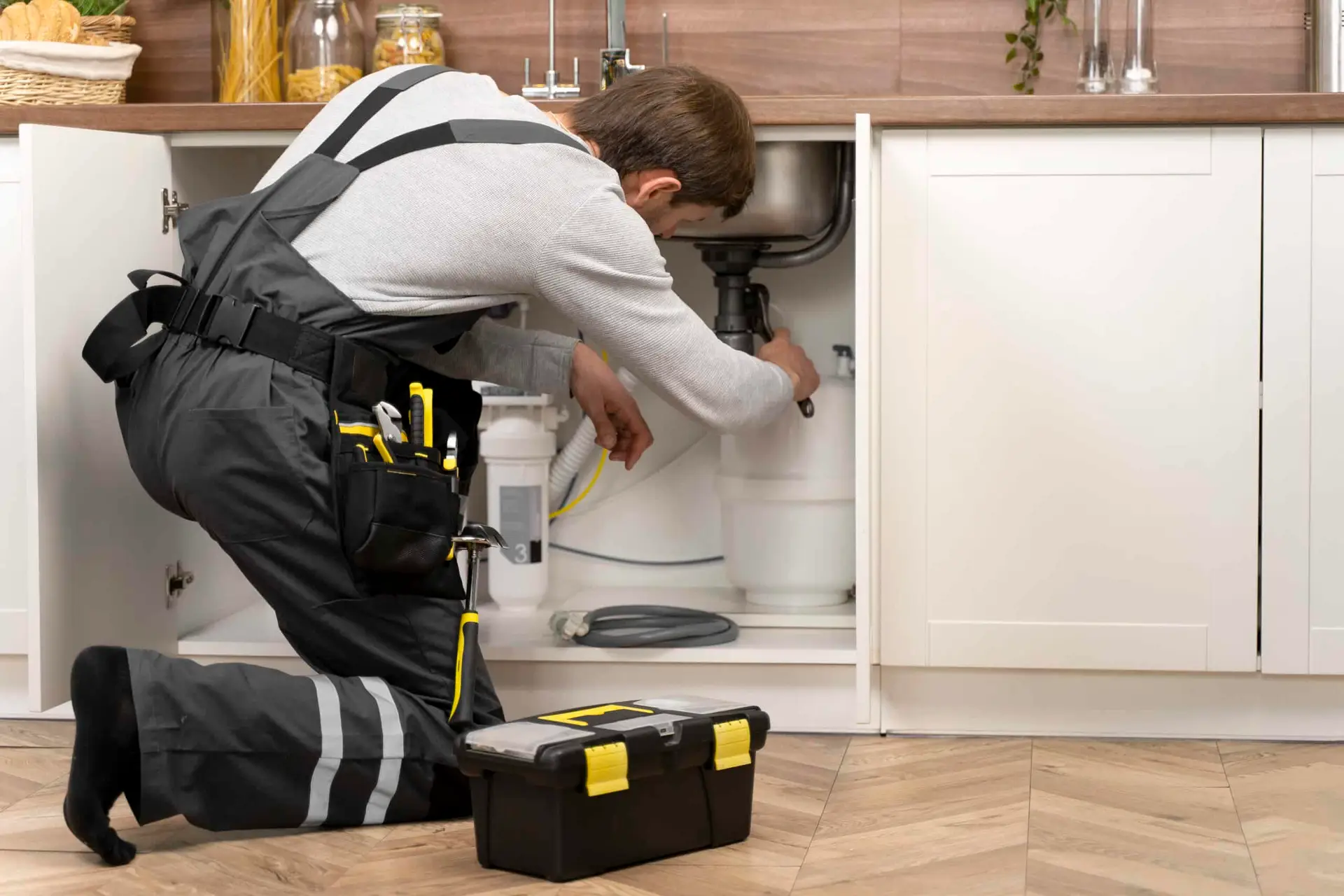Bathroom drains collect soap scum, hair, skin flakes and tiny bits of waste, which can cause clogging and slow drainage. When it comes to clearing said blockages safely, reach for a combination of warm water and gentle, natural cleaners like baking soda and vinegar. Most folks just smell weird odors or see water collecting, both typical hidden buildup indications. These commercial drain cleaners can eat away at your pipes if over-used, so stay with gentle, non-corrosive choices. Things stay clear with regular maintenance — like pulling hair off the drain screen and flushing with hot water. Understanding what lurks in your drain helps you choose the best way to clear it. The following parts detail safer cleaning action and daily care tips.
Key Takeaways
- Bathroom drains are an ecosystem of microbiomes, biofilm, hair, soap scum, skin cells, oils and who knows what else that form the backbone of these clogs and affect drainage.
- Biofilm acts as a magnet for both debris and bacteria, raising the health stakes and mandating mechanical and enzymatic disruption for removal.
- Consistent use of drain strainers/covers and rinsing out on a regular basis can do a lot to lower hair, skin cell, and foreign object build-up and keep the water flowing.
- By recognizing early warning signs, including slow drainage, gurgling noises, and bad odors, you can address the problem before it results in significant backups or damage.
- Boiling water, baking soda and vinegar, plungers and drain snakes are among the safe clearing methods that provide effective alternatives to harsh chemical cleaners, maintaining plumbing health and mitigating health risks.
- Proactive care — regular drain cleaning, use of guards and household education — is the key to avoiding the next clog and maintaining your drains for the long haul.
The Unseen Ecosystem in Your Drains
Underneath, our bathroom drains create a thriving, shifting biofilm of microscopic and organic substances. This ecosystem thrives in damp, sealed pipes, where gunk, strands and residue accumulate. They’re more than a hassle — these buildups can impede water, cause odors, and occasionally breed micro-fatbergs. Knowing what’s in it—and how it develops—assists in smart, sustainable solutions.
1. The Biofilm Matrix
Biofilm occurs when bacteria and fungi adhere to pipe walls, bonded together by slime-like substances they secrete. This gluey matrix traps detritus, hair, and soap, becoming thicker and thicker. Heat, moisture and nutrients — organic bits from skin and soap — accelerate formation of biofilms in drains. Biofilm can harbor pathogens and activate odors. It diminishes water flow by constricting the pipes. To disrupt biofilm, scrub the drain’s opening, flush with boiling water, or use enzyme cleaners to dissolve it safely.
2. Hair and Keratin
Hair, as you probably expected, is the primary culprit in most bathroom clogs. It snags, accumulates in traps or bends, adheres to soap or grease, creating persistent mats. Keratin, the hard protein in hair, fights decomposition, so these blockages don’t disappear. Cut hair and brushing loose can pile up quick. Employ a drain strainer, a no-nonsense first step. It traps hair before it slides into the pipes. Clean strainers frequently and never flush cut hair down toilets or drains.
3. Soap Scum and Minerals
Soap scum is created when soap combines with the minerals in hard water to form a chalky residue. This gunk adheres to pipes, traps additional filth, and constricts water passage. Over time, draining becomes sluggish as scum accumulates. Mix equal parts vinegar and water for routine scrubbing. Flush it down the drain to safely dissolve slime. Keep buildup at bay by scrubbing drains once a week and by using less soap or going for the liquid varieties.
4. Skin Cells and Oils
Skin cells and body oils slough off during washing and wash down drains. These combine with hair, soap, or minerals to create organic sludge. The gooey combo can adhere to pipe walls, ensnaring additional gunk. Number 2: rinse your drain with hot water after showers to flush away buildup. Enzyme drain cleaners, for example, help jumpstart the decomposition of these substances, helping your pipes stay clear.
5. Foreign Objects
Floss, wipes, cotton buds and jewellery frequently find their way into drains accidentally. Paper products and coffee grounds or starchy foods can cause blockages too. Use drain covers and don’t flush anything that won’t dissolve. Inspect drains regularly and clear obstructions. Maintenance is simpler than clearing a complete clog.
Diagnose Your Bathroom Drain Clogs
Bathroom drains gather up something more than water. Hair, soap and small debris accumulate over time, impeding flow and causing clogs. Catching those warning signs early is key. Employ your senses—listen, look, smell. Follow repeat offenders to identify tendencies and intervene before things get bad.
Slow Draining
Slow drains are a tip off to something bad. Usually it means a clog is beginning. Hair and soap scum are the go-to villains. If you notice water stalling in the sink or tub, it’s time to inspect the drain. Test your bathroom drain clogs with hot water to break up light buildups. This is fine for small clogs, but it’s not a remedy, just a temporary patch. Place drain strainers in your bathroom sinks and showers to trap debris prior to it going down the drain. Plan for regular inspections, particularly in older houses, to prevent minor problems from escalating.
Gurgling Sounds
If your drains gurgle when you drain water, it’s because there’s air stuck somewhere. This sound usually indicates an obstruction further down the pipe. The noise is caused by air bubbles trying to slip by the clog. Gurgling can alert you before water backs up or drains give out. Plunge to clear the clog and release any air pockets. If the noise returns or intensifies, you might require a snake, which fractures more stubborn blockages and assists in reestablishing flow.
Foul Odors
Foul odors emanating from a drain tend to signify that there is some decaying organic material in its interior. These smells are typical of ancient pipes or locations with substandard maintenance. Here’s a quick table for causes and fixes:
Source | Remediation Method |
Hair/Soap buildup | Remove debris, flush with hot water |
Food waste | Baking soda + vinegar, flush drain |
Mold/bacteria | Natural cleaners, regular cleaning |
Natural cleaners such as baking soda and vinegar can assist in clearing out the buildup and neutralizing odors. Do not wait until there is a problem, clean drains on a scheduled plan.
Water Backup
Water caking in the sink, tub or shower indicates a serious blockage. This results in water on the floor and expensive damage. Don’t delay — snatch a plunger or snake to dismantle the blockage. Chemical cleaners or lye can assist, but heed all safety directions. If the problem persists, give a professional a call. Recurring backups usually indicate a bigger issue buried in your plumbing system.
Safe Clearing Methods
Bathroom drain clogs accumulate. They originate from hair, soap scum, grease, and other debris. Though the chemical cleaners sold at your local grocery store offer fast solutions, a lot of them include harsh chemicals that can erode your pipes and hurt the planet. Safer non-toxic methods safeguard your plumbing as well as indoor air quality and reduce chemical waste. Here are some tried and true, real world methods for safely clearing bathroom drains.
- Boiling water
- Baking soda and vinegar
- Plunger use
- Drain snake
Boiling Water
Boiling water is a simple, efficient method of clearing minor obstructions from grease and soap buildup. Carefully pouring the water down the sink allows the heat to burst sticky buildup down. For best results, do this a few times a month. It’s an easy habit that can prevent minor clogs before they turn into big issues. You can’t use boiling water with PVC, because the heat could soften or warp the plastic.
Baking Soda and Vinegar
Baking soda and vinegar. Begin by dumping 1/2 cup of baking soda down the drain. Proceed with 1/2 cup of vinegar. Plug the drain for approximately 15 minutes allowing the fizzing action to dislodge grease and gunk. Flush the bathroom with hot water to rinse out the loosened gunk. So many of you use this monthly to keep things clear flowing and to shy away from harsh chemicals. For additional cleaning strength, add ¼ cup baking soda, ¼ cup salt and a tablespoon of cream of tartar—rinse with hot water.
Plunger Use
A plunger can unclog persistent snags in an instant. Choose a cup plunger for sinks and a flange plunger for toilets. Fill the sink with enough water to cover the cup of the plunger and then use fast, powerful pumps for 20–30 seconds to generate suction and move the clog. Of course, always have a clean plunger on hand, just in case. This one’s a reusable tool and it works without chemicals.
Drain Snake
A drain snake (known as an auger) penetrates deeper clogs that even plungers or hot water can’t clear. Insert the flexible metal coil into the drain and twist until you meet resistance, then rotate and push to shatter the muck. Clear the blade after every use to maintain its preparation. For heavy duty blockages, renting a professional-grade snake is a clever move. Because it’s mechanical, it steers clear of chemical hazards and goes right for stubborn clogs.

The Hidden Dangers of Chemical Cleaners
Chemical drain cleaners might seem like a quick solution to bathroom clogs, but they carry serious dangers. A majority of them rely on caustic bases like sodium hydroxide (lye) or potassium hydroxide. These can burn skin and eyes, and if you inhale the fumes, can result in breathing problems—even more so in an inadequately ventilated area. For glove or goggle skippers, it goes up quickly. Eye contact requires immediate flush under running water for 15 minutes, then a physician. Some 3,000 Americans a year get injured by these chemicals, heat burns accounting for a big portion of the harm.
Chemical drain cleaners can damage your pipes, too, not just you. Since the harsh reaction heats up the pipe walls, it can cause warping and cracks in PVC or older metal pipes. In septic systems, just a little bit of drain cleaner can wipe out beneficial bacteria for as long as 48 hours. That translates to sludge accumulation, tanks filling up sooner and costly clean ups. Compromised plumbing and septic systems can cause a minor clog to become a huge and expensive issue, requiring things like complete pipe replacement or additional septic pumping.
Sure, chemical cleaners open drains permanently, many users swear by them, but the solution is almost always temporary. These cleaners chemically break down hair and gunk, but they can’t always penetrate or dissolve the entire clog. Others adhere to the pipe walls, becoming a magnet for new accumulation. After a week or two, the water may slow again, and the cycle continues. The problem persists, resulting in more chemicals, more blockages, and occasionally enduring pipe damage.
Chemical drain cleaner fumes don’t just threaten bystanders. When these chemicals seep into water supplies, they can impact the broader ecosystem. A 2021 report discovered that 46% of US rivers and streams are in bad shape, partially due to household chemicals. The effect extends past the house, upsetting the ecosystem in streams and poisoning fish.
Safer alternatives are worth a peek! Options such as drain snakes, plungers, or even just baking soda and vinegar mixes can combat minor blockages without having to resort to caustic chemicals. Enzyme-based cleaners digest gunk without annihilating beneficial bacteria or damaging pipes. These alternatives eliminate health and pipe hazards and are gentler on the planet.
Proactive Drain Maintenance
Nothing keeps drains clear like a good cleaning habit. For daily use drains, such as the bathroom or kitchen, a bi-weekly cleaning works best. Less frequently used drains can be cleaned on a monthly basis. This maintenance habit does much to prevent accumulation prior to it becoming a serious blockage. In the kitchen, pour very hot water down the sink at least once a week. This easy step helps dissolve soap and grease that cling to pipes. A combination of baking soda and vinegar does the trick for cleaning and deodorizing. Pour in 1/2 cup baking soda, then 1/2 cup vinegar, wait fifteen minutes, then flush with hot water. These simple steps utilize products found in most kitchens and reduce the reliance on aggressive chemicals.
Drain strainers and guards are simple but essential equipment. They trap hair, soap residue and food bits before these become lodged in pipes. Slip a mesh strainer over bathroom and kitchen drains. Rinse the strainers frequently, discard what you collect. This action maintains drains clear and secure. In the kitchen, never pour grease down the sink. Cool it, then bag it up and toss it in the garbage. Grease congeals and clogs pipes, even far away from the sink, exacerbating over time. In your bathrooms, extract hair from the drain after each use. This small behavior keeps water moving and cuts down on costly repairs later.
Expert drain cleaning can aid where home remedies fail. Plumbers can use their tools and skills to clear deep blockages and clean pipes without causing any damage. For multi-person households or older plumbing, an annual inspection by a plumber is a smart choice. They’re able to detect minor issues in advance and maintain good water flow.
Because, as with most things, teaching everyone at home the right habits is key. Recalls people what belongs and doesn’t belong down drains. Rocks, food chunks, coffee grounds and wet wipes should go in the garbage, not down the pipes. Go for natural or bio cleaners, not harsh acids that eat away at pipes and harm the environment. Easy, common sense guidelines prevent the majority of drain issues.
Conclusion
When it comes to drains, stay in shape – know what accumulates inside. Hair, soap and grime cling to pipe walls. Bacteria and mold enjoy hiding out in our damp, dark nooks. Over time, they combine and decelerate water flow. In fact, just a plunger or drain snake removes the majority of obstructions. Baking soda and vinegar loosen gunk with no strong odors. Store-bought chemicals can damage pipes and create health hazards. Inspect drains frequently, scoop out strands, and utilize mesh covers. Be on the lookout for sluggish drains or foul odors. Little strides keep pipes clean and secure. Want to keep your bathroom fresh and functional? Give these hacks a whirl, and spread the word with your own solutions. Your story can help another.
Frequently Asked Questions
1. What causes most bathroom drain clogs?
Hair, soap scum, and dirt are the primary offenders. These things cling and ensnare other detritus, impeding water flow and creating blockages.
2. Are bathroom drains a health risk?
Yes. Your drains are a breeding ground for bacteria, mold, and mildew. These little buggers can produce stinky smells and can exacerbate allergies or illness if not washed away consistently.
3. Can I clear a clogged drain without harsh chemicals?
Yes. Try a plunger, or using a drain snake, or a baking soda and vinegar solution. These safe methods clear clogs without wrecking pipes or posing environmental hazards.
4. Why should I avoid chemical drain cleaners?
Chemical cleaners can corrode your pipes, contaminate the environment, and cause temporary blindness…5 if you breathe it in or get it on your skin. Safer, natural alternatives tend to work just fine — and are far less dangerous.
5. How can I prevent future clogs?
Put in drain covers to catch the hair and debris. Clean them regularly. Flush your drains with hot water or vinegar on a regular basis to prevent buildup.
6. How do I know if my drain is partially clogged?
Slow drainage, gurgling sounds, or odors are all indications of a partial clog. Deal with these early to prevent full-on clogs.
7. When should I call a professional for drain cleaning?
If do-it-yourself methods fail, or you observe frequent clogging, odors, or water receding, call in a pro. Ongoing issues can sometimes be a sign of underlying plumbing problems.
Dealing With Clogged Drains in Santa Rosa? Fast, Honest, Local Help Is Just a Call Away
Slow drains, gurgling toilets, or water backing up in your sink or shower? Don’t let a minor clog turn into a plumbing disaster. The trusted team at Yorkshire Plumbing & Drain Services is here to clear out stubborn blockages and get your drains flowing again. With nearly a decade of experience and the right tools for the job, we provide real solutions—never quick fixes or scare tactics.
Whether it’s your kitchen sink, bathroom drains, or a whole-house backup, we’re ready to help. Call or message us today for a no-cost estimate. We offer same-day service when possible and are always on standby for urgent jobs. Visit our Contact Page or give us a call—Yorkshire Plumbing is your go-to, family-owned team for clogged drains in Santa Rosa.
Disclaimer
The information provided on this website is for general informational and educational purposes only and is not intended as professional plumbing or construction advice. You should consult with a licensed plumber or qualified contractor for guidance specific to your home or situation. Do not rely solely on the content of this site to make decisions about plumbing repairs, installations, or maintenance. While we strive to keep the information current and accurate, it may not reflect the most recent industry standards or code requirements. Yorkshire Plumbing & Drain Services disclaims all liability for any actions taken or not taken based on the content of this site, to the fullest extent permitted by law.






